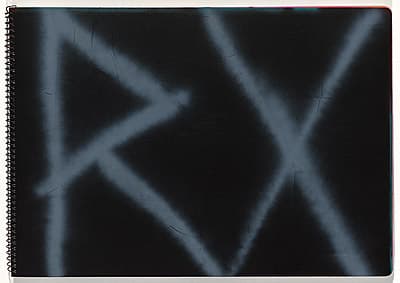REKS
Australia
1964
Chickenpox
2003-2004
stencil
undesignated impression
edition unknown
no manufacturer's mark
Not signed [except as stencil 'Reks' etc].
Not dated.
Not titled.
book (closed)
29.8 (h)
x
42.6 (w)
x
1.2 (d)
cm
Purchased 2010
National Gallery of Australia, Canberra
NGA 2010.545.1-62
Reks’s sketchbook, Chickenpox, evokes the viral spread of street art through the urban landscape. Like a rash, the images spread across pages. Some of them, like the stencils of scuttling cockroaches, might make you squirm with discomfort. Others, like his red and gold dragons, are pure visual pleasure – akin to scratching an itch. There are even pages filled with rash-like spotty blobs. More literally, Chickenpox reflects the time the artist spent ‘cooped up’ after catching chickenpox from his children over the 2003-2004 Christmas holidays. Unable to unleash his frustration through his usual work on the streets, Reks made this book as a way to express his pent up creativity. It documents some of his work from the previous year and ideas for new pieces.
This portfolio of Reks’s work gives an insight into the development of his creative processes. Like many sketchbooks, it shows the unfolding of an idea in sequence, developed through experiments with shapes and colour variations. An image of children in a playground changes mood with different coloured skies, and again with the introduction of a Star Wars space-ship motif borrowed from another page in the sketchbook. Reks zooms in on a face across three pages so that it becomes increasingly fragmented and abstract. There are also stand-alone pieces of social commentary, such as la guerre [war], in which a street-sign figure tosses his heart in the bin.
Chickenpox renders Reks’s work at once more intimate and more permanent. It brings art from the street into the art lover’s hands. Rather than the enveloping, social experience of art in the streets, stencil art can now be enjoyed as a private affair in the home; rather than a fleeting work that is to be enjoyed in and for the moment, the viewer can return to the work again and again, appreciating every nuance.
Elizabeth Howell

